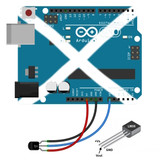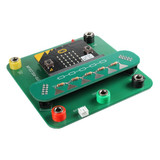ProtoPIC Blog
What is Ohm's Law?
Are you curious about how electricity works? Let me introduce you to a very important concept in electrical engineering called Ohm's Law. It's named after Georg Simon Ohm, a German physicist who discovered it in the early 19th century. Don't worry, though – we won't go too much into the history of it.Ohm's Law is a very simple formula that helps us understand the relationship between voltage, current, and resistance in an electrical circuit. Before we dive into the formula, let's understand
…
9th Mar 2023
How do I control a central heating system using an Arduino
To control a heating system using an Arduino, you will need to write a sketch (program) that implements the logic you want. Here's a basic outline of the steps involved:Connect your heating system to the Arduino. Depending on the type of heating system you have, this might involve connecting a relay or a solid-state relay to control the power to the heating elements, or interfacing directly with a heating controller.Choose a temperature sensor to measure the ambient temperature. The most commonl
…
7th Feb 2023
The Versatility of Slotted Aluminium Extrusions: From Robotics to Camper Van Renovations
In today's ever-evolving world, the need for versatile and adaptable building materials is greater than ever. From industrial automation to home renovation projects, the ability to create custom designs and structures is a must. Slotted aluminium extrusions offer a perfect solution for this need. These extrusions provide a lightweight yet durable foundation for a wide range of projects. They are easy to work with, easy to customize, and easy to install. They can be used for both indoor and outdo
…
25th Jan 2023
How to Solder
How to Solder for Beginners
If you want to make anything that involves an
Arduino, raspberry pi or any kind of circuitry, the odds are that you are going to have to solder something to a circuit board.
Learning how to Solder is a key skill to master if you want to work with electronics. It’s tricky, but not too hard – if you want to attach
…
28th Sep 2021
Happy Star Wars Day - May the 4th be with you!
Happy Star Wars Day, May the 4th be with you!
We've put together a ditty using a BBC micro:bit and a small pc speaker.
We'll be uploading the code shortly!
…
4th May 2021
Plastic Packaging - Reduce, Re-Use, Recycle
Proto-Pic Packaging - What is it made of?At Proto-Pic we aim to promote environmentally conscious design! Recently we've had quite a few people reach out to express concern about the environmental impact of the plastic boxes we use as packaging. Hopefully this blog will clear up some eco-myths around plastic and motivate you not to throw our packaging in the bin with some of the cool possibilities for them you'll read about below. The three R's - reduce, reuse, recycle - is a good
…
6th Apr 2021
Using Visual Studio Code with Raspberry Pi Pico:
Getting Started with
Pi Pico
This month the Raspberry Pi Pico got released, and we're mighty excited. Could this be the best means of low cost micro control available?? The Pi foundation have released their own brand of silicon and this device is known as the RP2040. There are boards in the pipeline from both Adafruit and Sparkfun, but for now, lets get started with the Pico from Raspberry Pi!
Well call us curious, but the first thing we did is plug it into a PC running Win
…
18th Jan 2021
Teaching Potential Dividers with the BBC Microbit and Physbit
Classroom Lesson Plan for the BBC Microbit
Teaching Potential Dividers with the BBC Microbit and Physbit
In this post, we have provided a complete classroom lesson plan, to aid in the teaching of a potential divider circuit, using the
BBC Micro:bit and the Phys:bit board.
The
Phys:bit is an addon system which allows included prewired plugin modules to easily connect to the BBC Micro:bit for teaching various concepts about electricity and electronics.
If you wish to pr
…
17th Nov 2020
Adding an LDR to your Arduino Project
What is a Light Dependent Resistor (LDR)?
An LDR is used to detect light levels in a wide range of household and industrial projects, such as security lighting. They are in essense a variable resistor, that varies its resistance as the light intensity increases or decreases.
In the dark or at low light levels, the resistance of an LDR is higher meaning that less current can flow through it. Transversely under a bright light the resistance of an LDR is lower meaning that more current
…
11th Nov 2020
Getting Started with Force Sensitive Resistors (FSR)
What is an FSR?
You know when people say the clue is in the name... Well, sometimes it really is. A Force Sensitive Resistor, or FSR as we'll call it, is a resistor that changes its resistance with force. When you press, stand, or hit it, its resistance changes.
FSRs come in a wide variety of sizes, so can be used for a huge array of projects. Maybe an electronic whoopee cushion??? Combine a
Wav Trigger loaded with some "popping off" sounds connected to an FSR under a chair
…
26th Oct 2020










